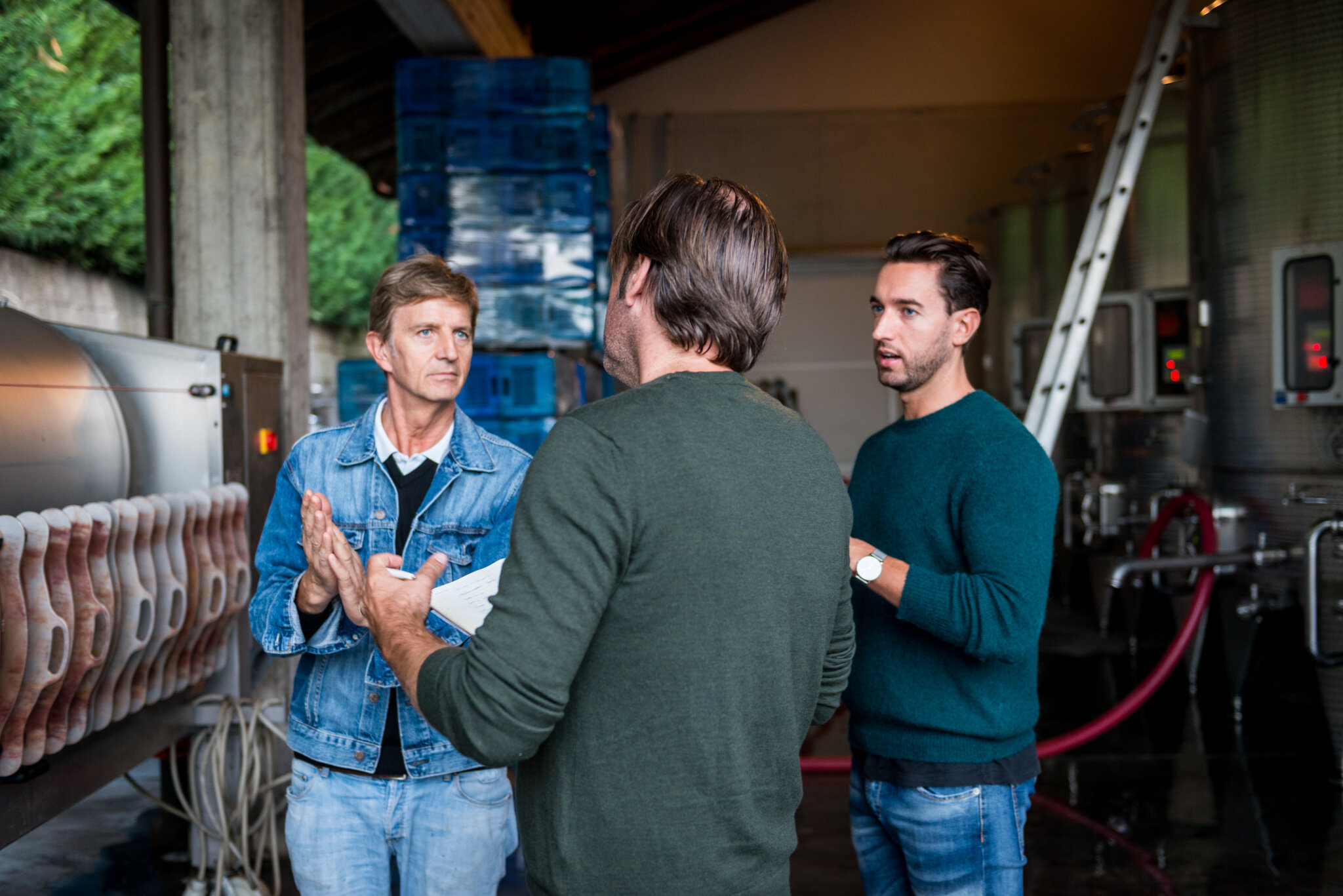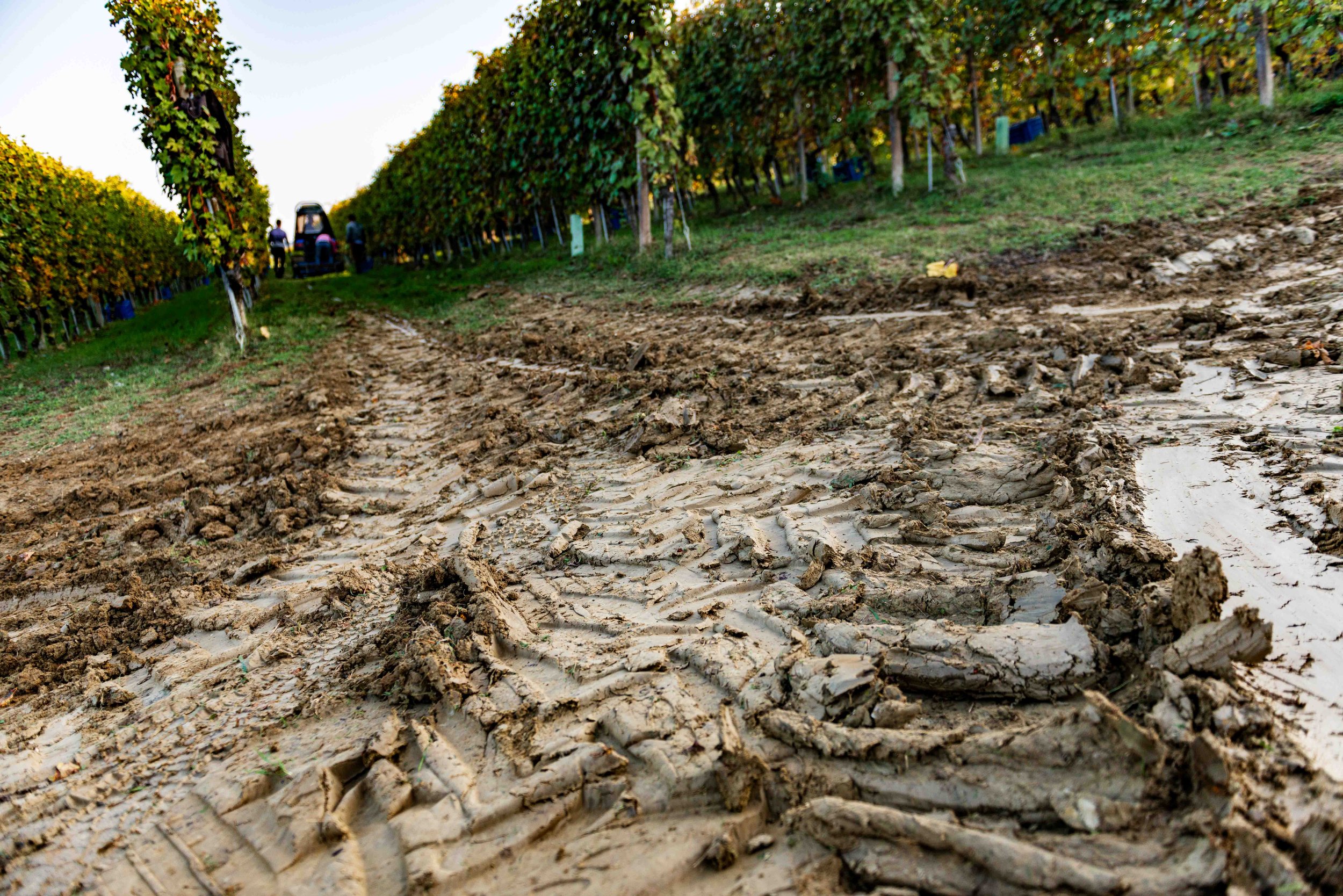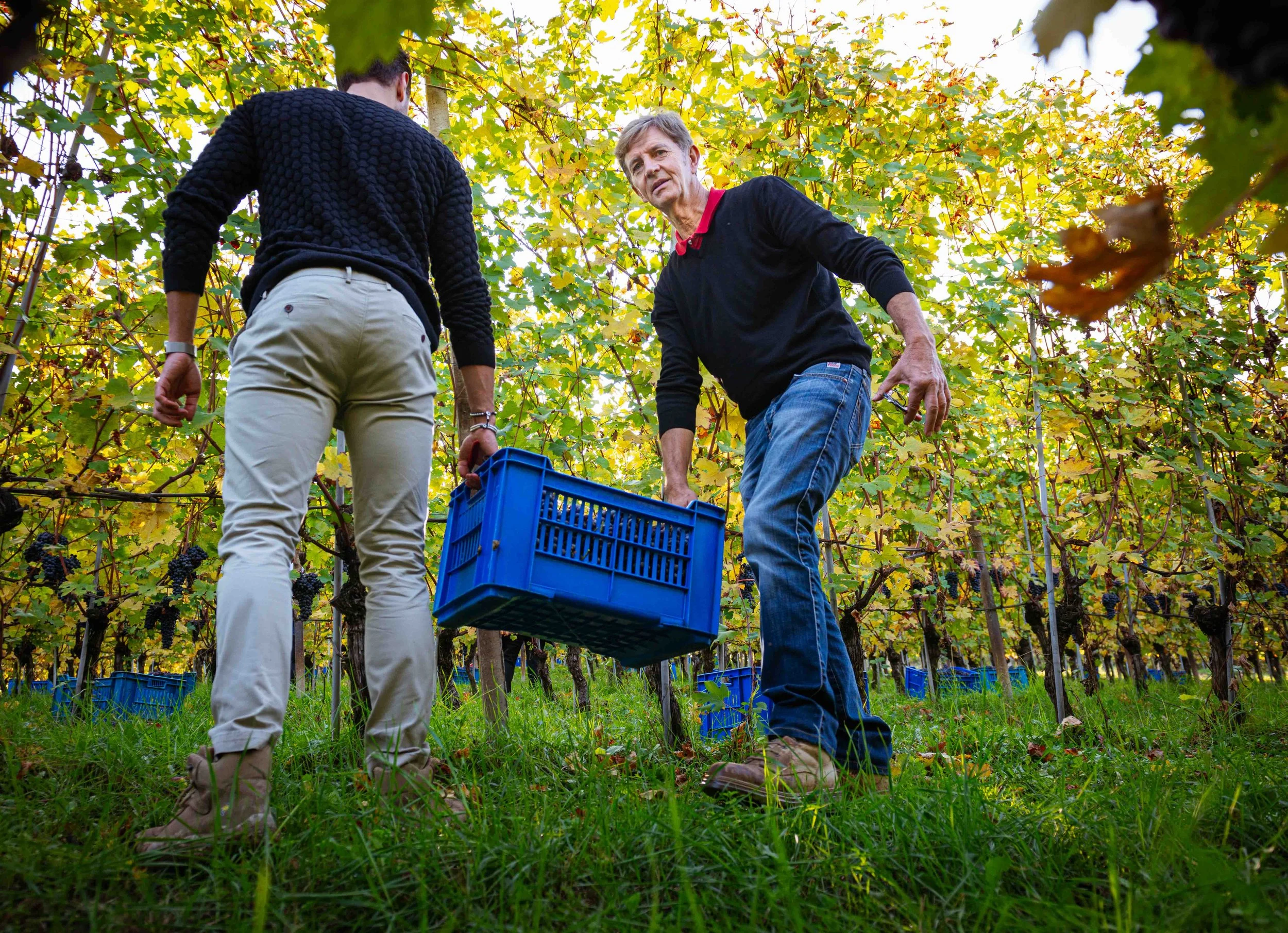





















Azelia
Who: Luigi, Lorella & Lorenzo Scavino
Where: Montelupo Albese, Castiglione Falletto & Serralunga d’Alba (Piemonte, Italy)
What grapes: Dolcetto, Barbera, Nebbiolo
Key facts: A fifth generation winery, Azelia produces highly sought after wines of the Langhe with extreme precision at every step of the production.
Website: http://www.azelia.it/en/
Instagram: @lorenzo_scavino_azelia
Azelia “Bricco dell’Oriolo” Dolcetto d’Alba DOC
Viticulture: Organic
Soil type: Calcareous tending to sandy
Elevation: 600m
Grapes: Dolcetto, single vineyard, South facing in Montelupo Albese
Method of fermentation: 7 days at 27 degrees C, aged in Stainless Steel
Average age of the vines: 55 years
Bottles: 13,600
A Scavino relative planted this site with Dolcetto. The field is on the top of a hill, facing south. A location always reserved for Nebbiolo, planted to Dolcetto. It’s a revelation. I’m sure the accountant at Azelia wishes Bricco dell’Oriolo could be replanted post haste. But I’m thrilled to have this excellent affordable red wine available again in North Carolina. Bricco dell’Oriolo poses a question. What if the world’s “little” grapes were given prime locations, and treated like their illustrious peers? Mid-weight, cool, seamless. Violet and black cherry aromas. Some tannin. Take a chance on Dolcetto. Serve it with wild mushrooms cooked in Delitia-brand butter, with sea salt and fresh thyme. — JM
Azelia Nebbiolo Langhe DOC
Viticulture: Organic
Soil type: White Calcareous
Elevation: 350m
Grapes: Nebbiolo, South-West facing in Castiglione Falletto & Serralunga d’Alba
Method of fermentation: 7 days at 28 degrees C, aged in Stainless Steel
Average age of the vines: 20 years
Bottles: 15,200
I’m not patient. I’ve been waiting to drink this Azelia red for months. Soon I’ll open a bottle alongside the Giovanni Almondo Roero DOCG, for Langhe vs. Roero terroir exploration. Bereft of oak influence, this wine has a purity that exposes soil influence. It presents a textbook version of Langhe Nebbiolo’s aromatic profile. Spicy cherry, flowers, and chalk. It’s an appealing mix. Serve with Robiola, toasted nuts, and fresh fruit. Ripe persimmons, if you can find them. — JM
Azelia “Punta” Barbera d’Alba DOC
Viticulture: Organic
Soil type: Calcareous and clayey
Elevation: 250m
Grapes: Barbera, South-West facing in Castiglione Falletto & Serraluga d’Alba
Method of fermentation: approximately 15 days / 29 °C, 18 months in barrel
Average age of the vines: 60 years
Bottles: 6,700
Speaking of terroir, it doesn’t take a wine expert to notice the difference between this remarkable Barbera d’Alba, and any of the countless Barberas that we import from Asti, Monferrato, and beyond. Punta is the name of a 60-year-old vineyard. The wine is aged in used barrique. While the opulence that drinkers seek in Barbera d’Alba is present in this wine, Azelia makes their bottling clean, fresh, and balanced. It’s a delightful throwback. Midweight, chocolate cherries, spice and smoke. Serve it with pasta e fagioli. Cook the beans in beef stock, and toss in a bunch of julienned cavolo nero/lacinato kale a few moments before serving. — JM
Azelia Barolo DOCG
Viticulture: Organic
Soil type: White Calcareous tending to Clayey
Elevation: 250m - 370m
Grapes: Nebbiolo, South-West facing in Castiglione Falletto & Serraluga d’Alba
Method of fermentation: 20 days at 30 degrees C, 24 months in large casks
Average age of the vines: 45 years
Bottles: 29,400 (750mls) & 600 (1.5L)
This wine is harvested from seven parcels spread across Lorenzo and Luigi Scavino’s 16-hectare farm. Thirty percent of the fruit comes from their home village of Castiglione Falletto. The remainder is grown in neighboring Serralunga. Bright cherry. Clarity. After a series of drought vintages, it’s a relief to taste Barolo from a year where there was rain (in spring) and the harvest could be carried in the historically-common weeks of late October. A normal vintage. Not lacking challenges, but yielding mid-weight Barolo with immediate appeal. Braise some beef, and dive in headfirst. — JM
Azelia “Bricco Fiasco” Barolo DOCG
Viticulture: Organic
Soil type: White Calcareous
Elevation: 285m
Grapes: Nebbiolo, South Facing in Castiglione Falletto
Method of fermentation: 22 days at 31 degrees C, 24 months in small barrels
Average age of vines: 65 years
Bottles: 68,000 (750mls), 520 (1.5L) & 60 (3L)
2018 Vintage: Created in 1978, Bricco Fiasco was one of the first wines in the entire Barolo area to be identified as a cru/single vineyard bottling. The vines in Bricco Fiasco are now 85 years old. White calcareous soils give this wine exceptional elegance and freshness. To me, it’s an intoxicating cherry liqueur aroma that carries Bricco Fiasco to the top echelon of quality. It’s no small feat in Italy’s most illustrious wine growing region.
Azelia “Margheria” Barolo DOCG
Viticulture: Organic
Soil type: Clayey with Tufaceous Marls
Elevation: 370m
Grapes: Nebbiolo, South Facing in Serralunga d’Alba
Method of fermentation: 22 days at 31 degrees C, 24 months in large casks
Average age of vines: 50 years
Bottles: 8,100 (750mls), 520 (1.5L) & 60 (3L)
2018 Vintage: A very rare beauty. Margheria is an exceptional site, notable for possessing dry, white, compact clay/limestone soils, and sixty-year-old vines. The wine conveys intense minerality. Subtler than its companions in the Azelia portfolio, and prettier. Gentle on the palate. The texture is lighter than most. Ethereal. Delicate dried rose aromas. It’s my favorite of their five crus.
Azelia “San Rocco” Barolo DOCG
Viticulture: Organic
Soil type: Clayey and Calcareous
Elevation: 213m
Grapes: Nebbiolo, South Facing in Serralunga d’Alba
Method of fermentation: 22 days at 31 degrees C, 24 months in small barrels
Average age of vines: 55 years
Bottles: 8,600 (750mls), 520 (1.5L) & 60 (3L)
The 2017 San Rocco Barolo has more dark cherry-chocolate aromas. It seems to have a higher level of phenolic ripeness to me: the fruit aromas are more intense, in the foreground. There is substantial fine dry tannin. Other than tannin that will integrate with age, the texture is quite appealing. San Rocco isn’t overly heavy. It does showcase plenty of pristine ripe black currant fruit. — JM
Azelia “Cerretta” Barolo DOCG
Viticulture: Organic
Soil type: Clayey and Calcareous
Elevation: 360m
Grapes: Nebbiolo, South, South-West Facing in Serralunga d’Alba, guyot trained
Method of fermentation: with indigenous yeasts, for approximately 55 - 60 days with submerged cap / 31 °C 30 months in large casks
Average age of vines: 30 years (2016 is the first vintage produced by Azelia although they have owned the property for as long.)
Bottles: 3,600 bottles, 340 magum, 50 double magnums
2018 Vintage: Azelia’s newest cru offering is highly allocated. Unsurprising. It is a scant two and a half hectares of vines, planted with south and southwest sun exposure in the heart of Serralunga d’Alba. What’s it taste like? Red licorice. Lots of cherry. Wild mint. I only get to drink Cerretta in the company of Lorenzo and Luigi! Next time I open Cerretta it will be with agnolotti del plin, or beef-filled ravioli drizzled with a sage butter sauce.
Azelia “Bricco Voghera” Barolo Riserva DOCG
Viticulture: Organic
Soil type: Clayey and Calcareous
Elevation: 360m
Grapes: Nebbiolo, South Facing in Serralunga d’Alba
Method of fermentation: 25 days at 31 degrees C, 30 months in large casks
Average age of vines: 75 years
Bottles: 3,100 (750mls), 340 (1.5L) & 60 (3L)
The Nebbiolo vines in Azelia’s most revered Bricco Voghera are 120+ years old, and are planted on an extremely steep slope. According to Lorenzo, “they are like trees.” Old vine Nebbiolo berries have thicker skins, and contain less juice. So the bunches weigh less than clusters from younger vines. The 2010 Voghera Barolo Riserva shows appropriately mature aromas. Some acetone, followed by sweeter, darker fruit. Blackberry. The mid-palate fruit wows me more than the initial aromas. Voghera shows indisputable class and concurrent approachability. — JM
July 2021
Lorenzo Scavino lingers in front of a large, boxy grandfather clock, made by his grandfather. It still keeps time. “He made this before there was electricity.” The clock represents the meticulousness and dedication of an older generation.
The estate was named by Lorenzo’s great-great grandfather, after a small wildflower that once grew in abundance in the vineyards. The flower is gone today, and isn’t related to Azaleas common in the southern U.S.
Lorenzo’s father Luigi designed extra tall narrow stainless steel tanks used for wine storage in their compact cellar. The snug fit of these tanks really maximizes space. I’m surprised the design isn’t emulated by other wineries. To my amateur eyes it seems brilliant, a clear improvement on the ubiquitous round tanks surrounded by unused triangles of vacant space in nearly every other cellar.
Lorenzo and Luigi keep their wines macerating on the skins in these tanks for 50-60 days, as was commonly done in the past. Lorenzo is the fifth generation of his family to work this land in Castiglione Falletto. He is the child of a perfectionist. To be fair, his detail-oriented father Luigi also has something of a maverick, independent streak. For example, Luigi didn’t exactly tell his father (Lorenzo’s grandfather) he was buying a parcel of vines in neighboring Serralunga. He charged ahead, and simply snuck out each day to work the new vines. It wasn’t long before this subterfuge was noticed. Even forty years ago,, people didn’t move around much between the communes of Barolo. Luigi’s travels were conspicuous.
Perfectionism may be something of a prison, but it can also yield impressive results. Luigi built Azelia into a benchmark Barolo address. The winery just passed its centennial, with 25 people working their 16 hectares of vineyard, spread across three villages. On average, the winery makes 80,000 bottles of wine annually: Barolo, Nebbiolo, Barbera, and Dolcetto. Azelia’s beautiful Docetto vineyard came from Luigi’s grandmother’s family in Montelupo d’Alba, a hamlet that’s 40 minutes away by tractor. Not exactly a convenient place to work, but the remarkable exposition and age of the vines makes the endeavor worthwhile. Don’t tell Luigi, but the wine remains a true bargain of the Langhe: a complex, expressive red that you can buy for the cost of a good pizza.
We take a look around, at dusty old bottles with crumbling faded labels, and painstakingly selected large oak barrels from the best coopers in three European nations. Among these casks, a discussion of cellar work commences. It yields few surprises. Wines in this old family winery are unfiltered, and not clarified. Scavino uses a very soft pump (as expensive as a sports car, according to Lorenzo) that won’t crush or blemish the berries as they are moved from vessel to vessel. Azelia purchases custom-made thicker large barrels from Austria, Slovenia, and France, because the barrels are by necessity made from older oak trees, which contain sweeter tannins. The winery also demands the vessels remain unvarnished, so the wood can breathe. Varnish is for appearance only, and hides flaws. By being meticulous (some would say perfectionist) in these small decisions, Scavino ensures the expensive and materials-intensive barrels can be kept for 20-25 years or longer, which benefits everyone.
We settled around a wide table in Azelia’s tasting room. The space is decorated with countless awards, framed menus of long ago wine dinners, and stacks of Veronelli and Gambero Rosso guides.
We begin with the 2019 Bricco dell’Oriolo, the Dolcetto d’Alba grown on grandma’s farm. The wine is dark and smoky, yet cool in the mouth. Violet aromas dominate. The site is on the top of a hill, facing directly south: like a Barolo location. Early-ripening Dolcetto is often banished to the bottom of slopes, to shadier microclimates. Here we can taste Dolcetto reaching its full potential.
The 2020 Nebbiolo already has subtlety to its spicy cherry aromas. A wave of refreshing bright fruit culminates in fine chalky tannin. Tasted in August, the wine was perhaps too young, but I’m confident it’s on the path to being an expressive and enjoyable wine. There’s already a lot of flavor swirling around.
The 2017 Punta Barbera d’Alba is grown on 60-year-old vines. Punta means point: the wine is from the top of a steep hill. This is a throwback expression of Barbera. Dense. Ripe and spicy, tar and smoke. Bitter chocolate and dark cherry. The wine is aged in used neutral barriques. Punta reveals its real merit on the mid-palate. The wine becomes clean, fresh, and balanced. Smooth texture, medium-weight. This 2017 exceeded my expectations.
As a young man learning about winemaking, Luigi spent some time in France. There he saw green harvesting, and the results it achieved in the cellars of Burgundy’s vignerons. Luckily, his grandfather had peach and apple trees that were routinely green harvested, so when Luigi proposed the idea for their Barolo, the elder Scavino said, ‘let’s try it.’ This required real open-mindedness. At that time, Barolo production was still centered around making a large quantity of wine. In the end, everyone at Azelia was pleased with the results. The wines were better. Of course, green harvesting is now commonplace across the region.
The 2017 Barolo is blended from seven single vineyards. Thirty percent of the fruit comes from Castiglione Falletto, the remainder is from Serralunga. The cherry component in this wine is very encouraging. The wine has remarkable clarity of color and flavor. There is, unsurprisingly, a significant amount of tannin. 2017 was a drought year: the vines endured 50 successive days with no rain. But thankfully, the vintage only had a few exceptionally hot weeks. Because the average vine age is 50-55 years, these plants have deep root systems, and perhaps suffered less than younger plantings. While darker than 2016, it’s a wine in harmony with itself.
The 2017 Bricco Fiasco Barolo is a classic. Already beautiful. The aromas of this wine are truly exceptional. Bricco Fiasco comes from 85-year-old vines, replanted after the war. Intoxicating kirsch liqueur. Substantially tannic and certainly best with food, or decanting, or time. Bricco Fiasco was first made in 1978. It began with 2,000 bottles per year. Few farms did single vineyard bottlings at that time in Barolo.
The 2017 Margheria Barolo is more subtle, but perhaps even prettier than the Bricco Fiasco. Dried rose petals. Red fruit of remarkable clarity. Quite gentle on the palate, verging on lightness. The site is in Serralunga, a former mine with dry white compact clay soil. There’s bright acid on the finish, but the tannin feels unobtrusive already: moderate.
The 2017 San Rocco Barolo has more dark cherry-chocolate aromas. It seems to have a higher level of phenolic ripeness to me: the fruit aromas are more intense, in the foreground. There is substantial fine dry tannin. Other than tannin that will integrate with age, the texture is quite appealing. San Rocco isn’t overly heavy. It does showcase plenty of pristine ripe black currant fruit.
The 2017 Cerreta has a very appealing aromatic profile. I’ve never tried this wine before! Or maybe once, on my first visit to Azelia. Fading memories! All the bottles we imported last year (the first year of Cerreta’s production) sold in a flash. The mid-palate texture and intensity is impressive. After a while, red licorice emerges, alongside tart cherry, and mint. The wine feels energetic. I love it.
The Nebbiolo vines in Azelia’s most revered Bricco Voghera are 120+ years old, and are planted on an extremely steep slope. According to Lorenzo, “they are like trees.” Old vine Nebbiolo berries have thicker skins, and contain less juice. So the bunches weigh less than clusters from younger vines. The 2010 Voghera Barolo Riserva shows appropriately mature aromas. Some acetone, followed by sweeter, darker fruit. Blackberry. The mid-palate fruit wows me more than the initial aromas. Voghera shows indisputable class and concurrent approachability.
We ate lunch at the kind of restaurant where the view from the veranda is so breathtaking that you can’t really remember the food or wine. I think both were exceptional: certainly the wine list was impeccably deep in local legends. But what will remain in my memory for years to come is the sight of Luigi and Lorenzo surrounded by the vine-lined hills of Barolo, a curtain of cru vineyards framing their laughing, joking, amiable faces. A kind duo, taking time to explain their homeland to a relatively clueless visiting American importer. Patient, thorough, thoughtful work, the same process that makes their wines distinct. Azalea is a notch above, in a place where world-class red wines are commonplace.









